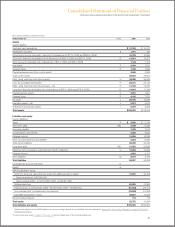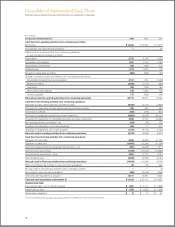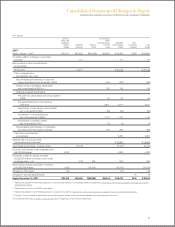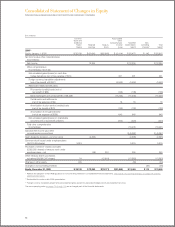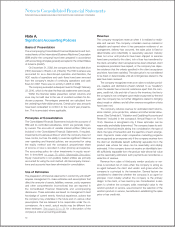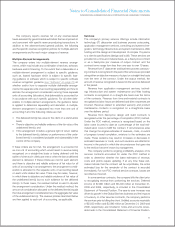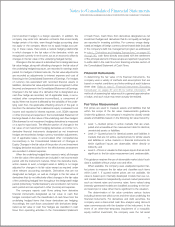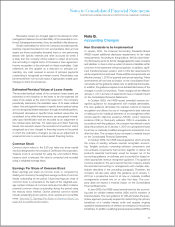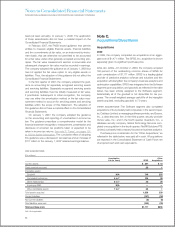IBM 2009 Annual Report Download - page 77
Download and view the complete annual report
Please find page 77 of the 2009 IBM annual report below. You can navigate through the pages in the report by either clicking on the pages listed below, or by using the keyword search tool below to find specific information within the annual report.
Notes to Consolidated Financial Statements
INTERNATIONAL BUSINESS MACHINES CORPORATION AND SUBSIDIARY COMPANIES
Environmental
The cost of internal environmental protection programs that are
preventative in nature are expensed as incurred. When a cleanup
program becomes likely, and it is probable that the company
will incur cleanup costs and those costs can be reasonably
estimated, the company accrues remediation costs for known
environmental liabilities. The company’s maximum exposure for
all environmental liabilities cannot be estimated and no amounts
are recorded for environmental liabilities that are not probable
or estimable.
Asset Retirement Obligations
Asset retirement obligations (ARO) are legal obligations associ-
ated with the retirement of long-lived assets. These liabilities
are initially recorded at fair value and the related asset retire-
ment costs are capitalized by increasing the carrying amount
of the related assets by the same amount as the liability. Asset
retirement costs are subsequently depreciated over the useful
lives of the related assets. Subsequent to initial recognition, the
company records period-to-period changes in the ARO liability
resulting from the passage of time in interest expense and revi-
sions to either the timing or the amount of the original expected
cash flows to the related assets.
Defined Benefit Pension and
Nonpension Postretirement Benefit Plans
The funded status of the company’s defined benefit pension plans
and nonpension postretirement benefit plans (retirement-related
benefit plans) is recognized in the Consolidated Statement of
Financial Position. The funded status is measured as the dif-
ference between the fair value of plan assets and the benefit
obligation at December 31, the measurement date. For defined
benefit pension plans, the benefit obligation is the projected
benefit obligation (PBO), which represents the actuarial present
value of benefits expected to be paid upon retirement based on
estimated future compensation levels. For the nonpension post-
retirement benefit plans, the benefit obligation is the accumulated
postretirement benefit obligation (APBO), which represents the
actuarial present value of postretirement benefits attributed to
employee services already rendered. The fair value of plan assets
represents the current market value of cumulative company and
participant contributions made to an irrevocable trust fund, held
for the sole benefit of participants, which are invested by the
trust fund. Overfunded plans, with the fair value of plan assets
exceeding the benefit obligation, are aggregated and recorded as
a prepaid pension asset equal to this excess. Underfunded plans,
with the benefit obligation exceeding the fair value of plan assets,
are aggregated and recorded as a retirement and nonpension
postretirement benefit obligation equal to this excess.
The current portion of the retirement and nonpension post-
retirement benefit obligations represents the actuarial present
value of benefits payable in the next 12 months exceeding the
fair value of plan assets, measured on a plan-by-plan basis.
This obligation is recorded in compensation and benefits in the
Consolidated Statement of Financial Position.
Net periodic pension and nonpension postretirement ben-
efit cost/(income) is recorded in the Consolidated Statement
of Earnings and includes service cost, interest cost, expected
return on plan assets, amortization of prior service costs/(cred-
its) and (gains)/losses previously recognized as a component
of other comprehensive income/(loss) and amortization of the
net transition asset remaining in accumulated other compre-
hensive income/(loss). Service cost represents the actuarial
present value of participant benefits earned in the current year.
Interest cost represents the time value of money cost associ-
ated with the passage of time. Certain events, such as changes
in employee base, plan amendments and changes in actuarial
assumptions, result in a change in the benefit obligation and the
corresponding change in other comprehensive income/(loss).
The result of these events is amortized as a component of net
periodic cost/(income) over the service lives or life expectancy of
the participants, depending on the plan, provided such amounts
exceed thresholds which are based upon the benefit obligation or
the value of plan assets. Net periodic cost/(income) is recorded
in cost, SG&A and RD&E in the Consolidated Statement of
Earnings based on the employees’ respective function.
(Gains)/losses and prior service costs/(credits) not recognized
as a component of net periodic cost/(income) in the Consolidated
Statement of Earnings as they arise are recognized as a compo-
nent of other comprehensive income/(loss) in the Consolidated
Statement of Changes in Equity, net of tax. Those (gains)/losses
and prior service costs/(credits) are subsequently recognized
as a component of net periodic cost/(income) pursuant to the
recognition and amortization provisions of applicable accounting
guidance. (Gains)/losses arise as a result of differences between
actual experience and assumptions or as a result of changes
in actuarial assumptions. Prior service costs/(credits) represent
the cost of benefit improvements attributable to prior service
granted in plan amendments.
The measurement of benefit obligations and net periodic
cost/(income) is based on estimates and assumptions approved
by the company’s management. These valuations reflect the
terms of the plans and use participant-specific information such
as compensation, age and years of service, as well as certain
assumptions, including estimates of discount rates, expected
return on plan assets, rate of compensation increases, interest
crediting rates and mortality rates.
Defined Contribution Plans
The company records expense for defined contribution plans for
the company’s contribution when the employee renders service
to the company, essentially coinciding with the cash contribu-
tions to the plans. The expense is recorded in cost, SG&A and
RD&E in the Consolidated Statement of Earnings based on the
employees’ respective function.
75


